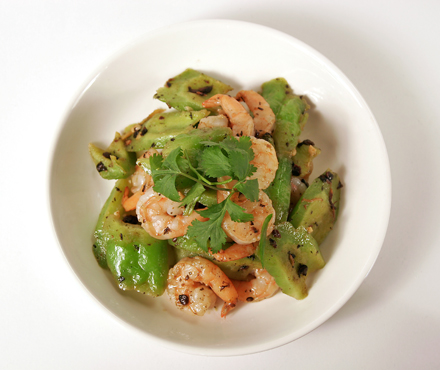In this Wednesday’s New York Times Food and Wine section Mark Bittman presented a stir-fry dish using fermented black beans (or douchi 豆豉). What a refreshing surprise it was to see such an esoteric ingredient presented in the mainstream media. I applaud Bittman for introducing this ingredient to his readers. It gives me an opportunity to expand on the information about fermented black beans and their uses.

Just like Bittman mentioned in his article the name is a misnomer. They are not made from black turtle beans that are commonly known in America, but from soybeans. The soybeans are usually steamed then allowed to ferment by introducing yeast. Salt and other flavorings are later added then the mixture is aged. Often the aging process also dries the beans. There are variations of fermentation processing as well, for instance using different fermentation agents and aging without drying. Certain variation results in a moist brown paste; such is the case of Sichuan chili bean paste (四川豆瓣醬).
Soybeans fermentation processing was first recorded in Shijing (食經), a Chinese text on culinary art, written roughly during the fifth century AD. Over the centuries this processing method spread throughout other East Asian countries. In Japan you will find fermented soybeans in various forms of natto, a foul smelling sticky soybean paste. Although the flavor of these products is different, the processing method is similar.
Fermented black beans are widely used throughout China. They make a very versatile flavoring ingredient. They can be used in stir-frying, steaming and braising. Some common examples of usage are in steaming fish or pork ribs, and in stir-frying clams and other seafood.

Photography by Ron Boszko
I used fermented black beans in a recipe for prawn and bitter melon for one of my stir-fry series posts. In that recipe I used the dry wok stir-fry technique resulting in a dish with intense fermented black beans flavor. Now that you’ve read the stir-fry series and are completely versed with stir-frying techniques, lets have some fun in analyzing Bittman’s recipe. Is that a moist or dry wok stir-fry? What do you think of the ingredient selection using prawn and bok choy? What do you think of keeping the sauce watery rather than thickening it with cornstarch? Post some comments and we’ll discuss.






Well, I don’t want to be too much of a curmudgeon, but I don’t really understand why there is all that sugar in there, or any sesame oil at all. It is supposed to be about black beans but he is not allowing them to shine.
Personally, I prefer a bit of cornstarch in my wet stirfries. Not as much as Chinese takeout restaurants use, but this recipe is too watery for me.
FineFuriousLife, I agree with you on the sesame oil and thickener!
Sesame oil has been abused by many Western chef. It is used in just about every recipes. Sesame oil is commonly used for cold dishes, some sweet dishes and for enhancing a stew or braising dish in Chinese cooking that I’m familiar with. I am with you on letting the fermented black beans define the flavor.
I also agree with you on thickening the sauce, it is especially appropriate when stir-frying leafy vegetable. A slightly thickened sauce will attach the flavor to it. Although I would not have added so much liquid to begin with.
I also probably would not have selected bok choy to compliment the prawn. I would use a more sturdy vegetable: a legume, root vegetable, asparagus or even broccoli. And perhaps Brussels sprout if one is inclined to be creative.
Great site. I agree with Kian and FineFuriousLife. But this is how my mom would make this, which I guess is the dry style. First rinse a heeping teaspoon of fermented blackbeans. Mince it if you wish, with two cloves of garlic. In a hot wok, add a two teaspoons of oil (canola or peanut). Add black beens and garlic and “chow” for 2 seconds. Add peeled shrimps. Stir fry for about 1 minute and remove. The shrimp would not be fully cooked. Clean wok, heat and add 1 teaspoon of oil. Add bitter melon slices or bok choi or any vegetable. Stir fry until you have little brown specks or till soft on the outside but still crisp inside. Now return shrimp into the wok. Add a teaspoon of soy sauce or oyster sauce. Stir for another minute.
I made this dish last night, following Mark Bittman’s recipe but without the fermented black beans. Unfortunately when I looked for them at Whole Foods, I was told they don’t carry them. I did use a lot of fresh ginger and extra garlic and tamari sauce. The dish was very good, but I’ll try an Asian market for the beans and will not use the liquid that Mark recommends when I make it again.